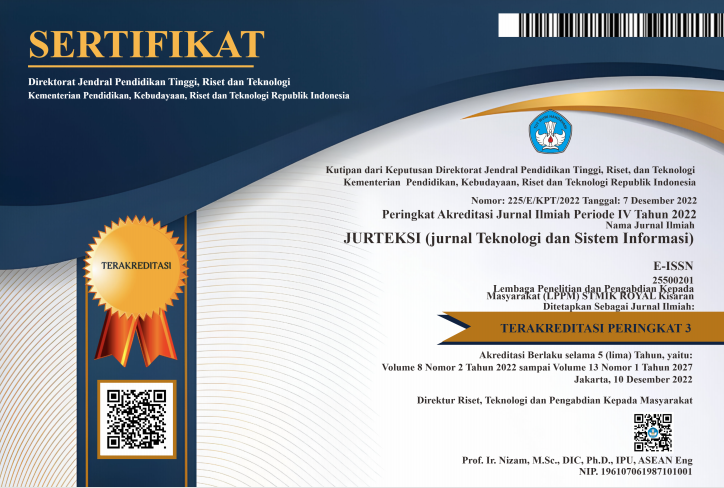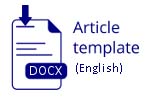IMPLEMENTATION OF THE FAST METHOD IN A WEB-BASED INVENTORY INFORMATION SYSTEM
Abstract
Abstract: The development of information technology has significantly impacted the efficiency and effectiveness of information system management, including inventory management. This research aims to implement the Features from Accelerated Segment Test (FAST) method in a web-based Inventory Information System to increase the speed of object detection and recognition in the stock monitoring process. The system development method in this research uses the Framework for the Application of System Thinking (FAST) which consists of 7 development phases. The FAST method helps ensure that the objectives are clear, specific, and achievable, ultimately leading to a more efficient and effective system. Implementing of this method in the web-based Inventory Information System is expected to provide faster and more accurate results in identifying stock changes, thereby minimizing the risk of shortages or excess inventory. Users can easily access real-time stock information via a responsive web interface. The system performance evaluation’s findings demonstrate that the FAST approach can speed up object detection, which benefits inventory management. Implementing the FAST method in a web-based inventory information system can bring many strategic and operational benefits and is expected to significantly increase the efficiency and accuracy of inventory management in an increasingly competitive market.
Keywords: FAST method; inventory; UML;website
Abstrak: Perkembangan teknologi informasi telah memberikan dampak besar terhadap efisiensi dan efektivitas pengelolaan sistem informasi, termasuk dalam hal manajemen persediaan barang. Penelitian ini bertujuan untuk mengimplementasikan metode FAST pada Sistem Informasi inventaris berbasis web guna meningkatkan kecepatan deteksi dan pengenalan objek pada proses monitoring stok barang. Metode pengembangan sistem menggunakan Framework for the Application of System Thinking (FAST) yang terdiri dari 7 fase pengembangan. Metode FAST membantu memastikan bahwa tujuan jelas, spesifik, dan dapat dicapai, yang pada akhirnya menghasilkan sistem yang efisien dan efektif. Implementasi metode ini pada aplikasi inventaris berbasis web diharapkan bisa membagikan hasil lebih cepat dan akurat mengidentifikasi perubahan stok barang, sehingga meminimalkan risiko kekurangan atau kelebihan persediaan. Pengguna dapat dengan mudah mengakses informasi stok barang secara real-time melalui antarmuka web yang responsif.Hasil evaluasi performa sistem menunjukkan bahwa metode FAST mampu meningkatkan kecepatan deteksi objek, sehingga memberikan kontribusi positif terhadap manajemen persediaan barang. Dengan adanya implementasi metode FAST pada Sistem Informasi inventaris berbasis web, dapat membawa banyak manfaat strategis dan operasional dan diharapkan bisa memberikan kontribusi signifikan dalam menaikkan efisiensi dan kecermatan pengelolaan persediaan barang di pasar yang semakin kompetitif.
Kata Kunci: metode FAST; persediaan barang; UML; website
References
A. R. Adiguna, M. C. Saputra, and F. Pradana, “Analisis dan Perancangan Sistem Informasi Manajemen Gudang pada PT Mitra Pinasthika Mulia Surabaya,†J. Pengemb. Teknol. Inf. dan Ilmu Komput., vol. 2, no. 2, pp. 612–621, 2018.
A. B. Putra and S. Nita, “Perancangan dan Pembangunan Sistem Informasi E-Learning Berbasis Web ( Studi Kasus Pada Madrasah Aliyah Kare Madiun ),†Semin. Nas. Teknol. Inf. dan Komun. 2019, vol. 1, no. 1, pp. 81–85, 2019.
M. Elsera, “Portal Publikasi Jurnal Karya Ilmiah Program Studi Sistem Informasi Ftk Universitas Harapan Berbasis Web Dengan Metode Fast (Framework For The Application Of Systems Thinking),†Bul. Utama Tek., vol. 14, no. 1, pp. 35–40, 2018.
M. Mesiono, H. Handoko, A. H. Siregar, and H. Hamdan, “Peran Strategis Teknologi Informasi dan Komunikasi di STIT Al-Ittihadiyah Labuhan Batu Utara,†J. Educ., vol. 5, no. 3, pp. 8362–8375, 2023, doi: 10.31004/joe.v5i3.1624.
N. W. Astuti, M. Kadafi, and M. Muhammadinah, “Implementasi Metode Fast Dalam Rancang Bangun Sistem Informasi Keuangan Pada Perguruan Tinggi Widya Dharma Palembang,†Jusifo (Jurnal Sist. Informasi), vol. 3, no. 1, pp. 41–58, 2017, doi: 10.19109/jusifo.v3i1.3859.
T. Sintosaro, Waruwu, and S. Nasution, “Sistem Pendukung Keputusan Pemilihan Investasi Saham Berbasis Web Menggunakan Metode SMART,†J. Mahajana Inf., vol. 5, no. 1, pp. 8–13, 2020, [Online]. Available: http://e-journal.sari-mutiara.ac.id/index.php/7/article/view/1191.
M. Noorhansyah and A. Pratomo, “Penerapan Model Customer Relationship Management Pada Metodologi Fast (Studi Kasus : Pengembangan Portal Akademik Jurusan Administrasi Bisnis Politeknik Negeri Banjarmasin),†J. POSITIF, vol. I, no. 2, pp. 25–32, 2016.
Eka Yulia Sari, Dina Yulina H, and Titik Rahmawati, “Pemodelan Sistem Optimasi Penjadwalan Matakuliah Dengan Algoritma Genetika,†Tek. Teknol. Inf. dan Multimed., vol. 4, no. 1, pp. 70–78, 2023, doi: 10.46764/teknimedia.v4i1.97.
D. N. Azizah and N. Nurgiyatna, “Pengembangan Sistem Inventory Barang Perusahaan Dagang berbasis Website (Studi Kasus: CV. Agung Nugraha),†Emit. J. Tek. Elektro, vol. 21, no. 1, pp. 42–48, 2021, doi: 10.23917/emitor.v21i1.13418.
R. M. N. Halim, “Sistem Informasi Penjualan Pada TB Harmonis Menggunakan Metode FAST,†J. Sisfokom (Sistem Inf. dan Komputer), vol. 9, no. 2, pp. 203–207, 2020, doi: 10.32736/sisfokom.v9i2.868.
E. Yanuarti, “Pengembangan Sistem Informasi Kebencanaan Menggunakan Metodologi FAST,†Konf. Nas. Sist. Inf. 2018, pp. 8–9, 2018.
R. R. C. Putra and E. B. Perkasa, “Aplikasi Peminjaman Ruangan Rapat Kantor Gubernur Provinsi Kepulauan Bangka Belitung Berbasis Android,†J. Sisfokom (Sistem Inf. dan Komputer), vol. 8, no. 2, pp. 191–198, 2019, doi: 10.32736/sisfokom.v8i2.688.
Z. Syahputra, “Website Based Sales Information System With The Concept Of Mvc (Model View Controller),†J. Mantik, vol. 4, no. 2, pp. 10–19, 2020, [Online]. Available: http://iocscience.org/ejournal/index.php/mantik/article/view/882/595.













